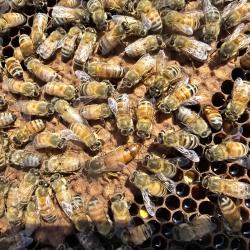Cracking Cryptography in the Classroom
UMD mathematics, computer science, and electrical and computer engineering majors can take a cryptography class to learn how modern communications and transactions are kept secure.
What keeps our emails and messages private? How do passwords protect our online accounts from hackers? Why is it safe to make purchases from retailers using our credit cards?

The answer to all those questions is cryptography—the process of hiding or coding information so that only the intended users can access it.
In 1997, just as the internet and digital communications like email became more commonplace, University of Maryland Mathematics Professor Larry Washington designed a new cryptography course. An expert in number theory and cryptography, Washington wanted to make sure students had some exposure to the rapidly advancing field and its potential applications before they graduated and encountered cryptography in real-life situations.
“There’s a lot of interest in cryptography here at UMD because the National Security Agency and other government agencies use cryptographic methods,” Washington said. “Cryptography is a subject that has developed very greatly in the past 50 years and a lot of that development happened in the past 20 years. As a result, we continually update the course to keep up.”
An evolving interdisciplinary approach
Nearly 30 years later, UMD’s cryptography course still lives on as MATH 456, CMSC 456 and ENEE 456. Due to its interdisciplinary nature, faculty members from the mathematics and computer science departments have taught the class and influenced the curriculum.
“It’s a blend of math and computer science ideas,” Washington explained. “The students see real-world applications of theoretical math ideas while students who are accustomed to only theoretical math have the chance to see the issues that arise in applied areas.”
Senior computer science major Harshit “Archie” Garg says the course was among the toughest classes he had ever taken at UMD but also one of the most eye-opening. He took the class in fall 2023, when it was taught by Computer Science Professor Daniel Gottesman, who also holds a Brin Family Endowed Professorship in Theoretical Computer Science. Initially unfamiliar with topics like encryption, Garg believes that the class gave him the tools he needed to understand cryptography’s place in everyday life and how it could be applied to seemingly unrelated fields.
“The class showed that you could use these fundamental math concepts like logarithms and exponents to create these very robust encryption protocols. I learned how we could generate key hashes dynamically on the fly, where something can be understood in one context but be complete nonsense in another,” explained Garg, who plans to pursue a career in machine learning. “I ultimately feel confident that wherever life takes me after graduation, I can use the concepts I learned from this class.”
That sentiment was echoed by many other students, including computer engineering Ph.D. student Russell Chiu (B.S. ’23, computer engineering), who took the class as an undergraduate. The class made such an impression on Chiu that he decided to become a graduate teaching assistant for the course in spring 2024. He hopes to apply what he learned in the course to his graduate research and eventually pursue a career where he can put his knowledge of cryptography and algorithms to work.
“With the rise in new types of computing, there are many interesting questions within both academia and industry. In fact, there were several new topics introduced to the course curriculum within the two years since I took it,” he added. “I definitely recommend this class to undergrads interested in cybersecurity and beyond—it covers a wide scope of topics that quickly evolve over time.”
Cryptography today and tomorrow
Todd Rowland, who worked at computational technology company Wolfram Research before he joined UMD as a mathematics lecturer, is excited to teach the newest iteration of the class in fall 2024. He hopes his experience with more abstract forms of cryptography at Wolfram will add an extra dimension to the course and underscore the ever-changing impact of cryptography.

“It’s no longer just about secret messages and passwords,” Rowland said. “Cryptography has become increasingly relevant to us ever since the internet came into existence. There are obvious things that cryptography plays a role in, like keeping credit card information safe while making secure payments over the internet. But it’s also helping you make sure the webpage you’re on is the right one and that no one altered it—authentication of integrity is more important than ever.”
In Rowland’s class this fall, students will explore concepts from basic ciphers to secret sharing schemes (a technique where a “secret” is split into multiple shares to different parties and can’t be fully accessed unless all shares are recombined). The curriculum will also cover the Data Encryption Standard and the Advanced Encryption Standard, globally used ciphers established by the U.S. government to protect sensitive electronic data. Rowland hopes the class will help students become more aware of the technology around them and how newer trends in cryptography—like blockchains and quantum cryptography—can impact society.
“The class is a peek into how the world works today, from knowing how to manage passwords and authentications to dealing with things like cryptocurrencies,” Rowland said. “As technology advances, it’s better to be prepared as best we can to work with those advancements. If you want to understand all these processes, this would be the class to take.”







